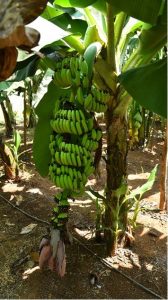BARC Unveils First Mutant Banana Variety to Benefit Farmers

In its ongoing efforts to improve livelihood of farmers and contribute to the food & nutritional security of our country, Bhabha Atomic Research Centre (BARC) has achieved a new landmark by developing Trombay Banana Mutant-9 (TBM-9), which was recently notified for release as ‘Kaveri Vaaman’ by the Government of India. This is a significant achievement as Kaveri Vaaman is not only the first mutant banana variety of India, but is also the first fruit crop developed and released by BARC. Notably, with Kaveri Vaaman, the total count of improved crop varieties released by BARC now stands at 72.
Dr. Ajit Kumar Mohanty, Secretary of the Department of Atomic Energy (DAE) and Chairman of the Atomic Energy Commission (AEC), applauded the release of TBM-9 as a major step in revolutionizing the improvement of horticultural crops in India through the use of ionizing radiation.
Director, BARC, Shri Vivek Bhasin, speaking on the occasion of BARC Founder’s Day-2025, highlighted the pivotal role played by gamma ray-induced mutagenesis in developing new crop varieties that are crucial for sustainable agriculture. He expressed that the release of TBM-9 was a blessing for farmers cultivating the economically important Grande Naine banana. He also noted that this development reflected the expansion of BARC’s mutation breeding programme from traditional crops to fruits and other vegetatively propagated plants.
Developed in a collaborative partnership with the Indian Council of Agricultural Research-National Research Centre for Banana (ICAR-NRCB), Tiruchirappalli, Tamil Nadu, Kaveri Vaaman, was obtained by mutagenizing the popular, widely farmed banana cultivar, Grande Naine, with gamma radiation. After several years of screening and rigorous field trials, TBM-9, which showed several superior agronomic characteristics over the parental cultivar, was selected for release.
Compared to the parental cultivar, a key advantage of Kaaveri Vaaman is its short stature, which makes these plants highly resistant to lodging (i.e. bending or breaking of stems), a major problem with the tall banana plants grown in windy areas along the coastline. Conventionally, bamboo or wooden poles are used as props to prevent lodging. As the new variety is dwarf and lodging-resistant, props are not essential, leading to a significant reduction in the input cost. The maturity period of Kaveri Vaaman is one and a half month less than the parent, enabling harvest in a shorter time. Besides these advantages, the banana fruit from the new variety retains all the typical organoleptic characteristics of the parent Grande Naine variety. Kaveri Vaaman is apt for high-density plantation as well as terrace gardening, qualities that support both commercial as well as household cultivation.
Dr. Mohanty further emphasized that the crop improvement program was a vital part of DAE’s research mission to utilize nuclear science for societal applications. He added that the release of 72 improved crop varieties till date was a testament to the meaningful role played by DAE in contributing to the agriculture sector of our country. He profusely acknowledged ICAR institutes and State Agriculture Universities for the substantial role played by them in evaluation and release of varieties developed by BARC.


